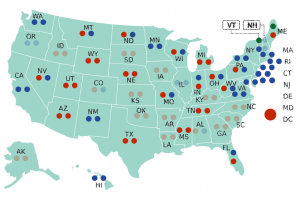By Sheryl Luna | Latina Lista
Longtime television journalist Geraldo Rivera challenges the public rhetoric and media perception of what defines today’s U.S. Hispanics, and in the process, crafts a personal portrait that is under-reported in the news.
Geraldo Rivera’s “HISPANIC: Why Americans Fear Hispanics in the U.S.” (Celebra 2008) is a play on the term Hispanic, which he divides into two words — “his†and “panic.†The book is a smooth read where Rivera addresses current fears about immigration and the “changing face of America.â€
He argues that the current fears are based on propaganda espoused by the media and the racial overtones in the media’s depictions of Latinos as criminals.
Rivera opens with an account of his own family’s immigration from Puerto Rico. This history is both personal and informative. Rivera probes the panic in chapter two and tries to understand the opposition and the debate surrounding immigration. He tells a tale of hard-working Latinos and their movement into the middle-class.

The book provides a lot of details, but Rivera successfully avoids dry academic prose in favor of a smooth flowing and honest reflection of his own history and the ongoing demonization of Latino immigrants by the media and anti-immigrant groups.
He compares this inflow to the hated immigration of the Irish and the Italians into the U.S. and draws on similarities between the successful assimilation into the larger society that those groups achieved and what is happening with the current Latino immigrants.
By examining a number of specific fringe groups to the extreme right of the political issue, such as the Ku Klux Klan’s growth in 2006 and the Minuteman and various newscasters such as Lou Dobbs, Ann Coulter and others, Rivera casts a much needed shadow over anti-immigration hysteria.
He questions anti-immigrant advocates such Tom Trancredo and Mary Lou Barletta. He admits he cannot understand their anti-immigrant sentiments since they both are from families of recent immigrants. He challenges statistics about the amount of federal aid undocumented workers attain as being overblown, as well as the media’s tendency to criminalize them when the majority are law-abiding citizens.
The book reads well and probes difficult and uncomfortable questions about anchor births by immigrant mothers who have their children in the U.S., as well as, how successfully Latinos have assimilated into the culture.
Rivera then asks us to examine ourselves and to encourage other Americans to personalize the issue rather than buy into the propaganda and fear. For example, we are encouraged to ask those opposed to the influx of immigrants whether or not they personally have lost a job to one, or know one personally.
Rivera’s book questions bold manifestos against the issue of a guest worker’s program and looks closely at the changing demographics in cities such as Denver and how Latinos have gained positions of power in local governments over time.
He does this with a personable and vivid voice. In doing so, he humanizes the plight of immigrants and shifts attention to their value to our society rather than media hyperbole.
The book is a quick read, yet intelligent and interesting. It is a needed counter-view to much of what is presented to the public at this time.
In addition to reviewing books for Latina Lista, Sheryl Luna is an award-winning poet who blogs on “Chicana Poeticsâ€.




